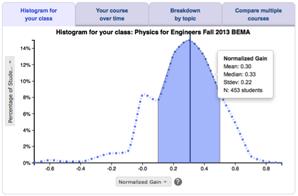
Developed by: Steven Pollock, Stephanie Chasteen, Bethany Wilcox, Qing Ryan, Charles Baily, and many others in the University of Colorado Boulder PER group and physics department




middle schoolhigh schoolintro collegeinter-mediateupper levelgrad school other





Overview
What? Supplementary activities for upper-level E&M. Includes learning goals, interactive lectures, homework problems, student difficulties, tutorials, in-class group activities, and clicker questions. All materials are modular and can be mixed and matched with other teaching strategies or materials.
Student skills developed
- Conceptual understanding
- Problem-solving skills
- Using multiple representations
- Making real-world connections
- Metacognition
Instructor effort required
- Medium
Resources required
- TAs / LAs
- Clickers / polling method
- Projector
Resources
Teaching Materials
You can download all course materials for free, including lecture slides, clicker questions, homework, exams, and solutions from the developer's website on PhysPort.
Research
This is the third highest level of research validation, corresponding to:
- at least 1 of the "based on" categories
- at least 1 of the "demonstrated to improve" categories
- at least 1 of the "studied using" categories
Research Validation Summary
Based on Research Into:
- theories of how students learn
- student ideas about specific topics
Demonstrated to Improve:
- conceptual understanding
- problem-solving skills
- lab skills
- beliefs and attitudes
- attendance
- retention of students
- success of underrepresented groups
- performance in subsequent classes
Studied using:
- cycle of research and redevelopment
- student interviews
- classroom observations
- analysis of written work
- research at multiple institutions
- research by multiple groups
- peer-reviewed publication
References
- S. Chasteen, Teasing out the effect of tutorials via multiple regression, presented at the Physics Education Research Conference 2011, Omaha, Nebraska, 2011.
- S. Chasteen, R. Pepper, M. Caballero, S. Pollock, and K. Perkins, Colorado Upper-Division Electrostatics diagnostic: A conceptual assessment for the junior level, Phys. Rev. ST Phys. Educ. Res. 8 (2), 020108 (2012).
- S. Chasteen, R. Pepper, S. Pollock, and K. Perkins, But Does It Last? Sustaining a Research-Based Curriculum in Upper-Division Electricity & Magnetism, presented at the Physics Education Research Conference 2011, Omaha, Nebraska, 2011.
- S. Chasteen, K. Perkins, P. Beale, S. Pollock, and C. Wieman, A Thoughtful Approach to Instruction: Course transformation for the rest of us, J. Coll. Sci. Teaching 40 (4), 24 (2011).
- S. Chasteen and S. Pollock, Transforming Upper-Division Electricity and Magnetism, presented at the Physics Education Research Conference 2008, Edmonton, Canada, 2008.
- S. Chasteen and S. Pollock, Tapping into Juniors’ Understanding of E&M: The Colorado Upper-Division Electrostatics (CUE) Diagnostic, presented at the Physics Education Research Conference 2009, Ann Arbor, Michigan, 2009.
- S. Chasteen and S. Pollock, A Research-Based Approach to Assessing Student Learning Issues in Upper-Division Electricity & Magnetism, presented at the Physics Education Research Conference 2009, Ann Arbor, Michigan, 2009.
- S. Chasteen, S. Pollock, R. Pepper, and K. Perkins, Transforming the junior level: Outcomes from instruction and research in E&M, Phys. Rev. ST Phys. Educ. Res. 8 (2), 020107 (2012).
- S. V. Chasteen, S. J. Pollock, R. E. Pepper, and K. K. Perkins, Thinking like a physicist: A multi-semester case study of junior-level electricity and magnetism, 80 (10) 923-930 (2012).
- J. Huffman, M. Vignal, and B. Wilcox, Investigating Upper-Division Students' Interpretations of the Divergence Theorem, presented at the Physics Education Research Conference 2020, Virtual Conference, 2020.
- R. Pepper, S. Chasteen, S. Pollock, and K. Perkins, Our best juniors still struggle with Gauss’s Law: Characterizing their difficulties, presented at the Physics Education Research Conference 2010, Portland, Oregon, 2010.
- R. Pepper, S. Chasteen, S. Pollock, and K. Perkins, Observations on student difficulties with mathematics in upper-division electricity and magnetism, Phys. Rev. ST Phys. Educ. Res. 8 (1), 010111 (2012).
- K. Perkins and C. Turpen, Student Perspectives on Using Clickers in Upper-division Physics Courses, presented at the Physics Education Research Conference 2009, Ann Arbor, Michigan, 2009.
- S. Pollock and S. Chasteen, Longer term impacts of transformed courses on student conceptual understanding of E&M, presented at the Physics Education Research Conference 2009, Ann Arbor, Michigan, 2009.
- S. Pollock, S. Chasteen, M. Dubson, and K. Perkins, The use of concept tests and peer instruction in upper-division physics, presented at the Physics Education Research Conference 2010, Portland, Oregon, 2010.
- S. Pollock, R. Pepper, S. Chasteen, and K. Perkins, Multiple roles of assessment in upper-division physics course reforms, presented at the Physics Education Research Conference 2011, Omaha, Nebraska, 2011.
- S. Pollock and B. Wilcox, Upper-Division Students' Use of Separation of Variables, presented at the Physics Education Research Conference 2015, College Park, MD, 2015.
- Q. Ryan, C. Baily, and S. Pollock, Multiple-Response Assessment for Upper-division Electrodynamics, presented at the Physics Education Research Conference 2016, Sacramento, CA, 2016.
- C. Wallace and S. Chasteen, Upper-division students' difficulties with Ampère's law, Phys. Rev. ST Phys. Educ. Res. 6 (2), 020115 (2010).
- B. Wilcox, M. Caballero, R. Pepper, and S. Pollock, Upper-division student understanding of Coulomb's law: Difficulties with continuous charge distributions, presented at the Physics Education Research Conference 2012, Philadelphia, PA, 2012.
- B. Wilcox, M. Caballero, D. Rehn, and S. Pollock, Analytic framework for students’ use of mathematics in upper-division physics, Phys. Rev. ST Phys. Educ. Res. 9 (2), 020119 (2013).
- B. Wilcox and S. Pollock, Multiple-choice Assessment for Upper-division Electricity and Magnetism, presented at the Physics Education Research Conference 2013, Portland, OR, 2013.
- B. Wilcox and S. Pollock, Upper-division student difficulties with the Dirac delta function, Phys. Rev. ST Phys. Educ. Res. 11 (1), 010108 (2015).
- B. Wilcox and S. Pollock, Validation and analysis of the coupled multiple response Colorado upper-division electrostatics diagnostic, Phys. Rev. ST Phys. Educ. Res. 11 (2), 020130 (2015).
- J. Zwolak and C. Manogue, Revealing Differences Between Curricula Using the Colorado Upper-Division Electrostatics Diagnostic, presented at the Physics Education Research Conference 2014, Minneapolis, MN, 2014.




